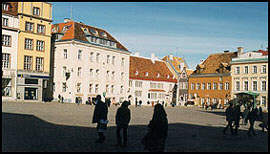 History History |

What is Estonia? A tiny piece of land at the coast of the Baltic Sea that has no hope for bright future? A merging gateway between East and West? Or an economic miracle, which hasn't been discovered yet by the rest of the world?
Estonia is a combination of all of these.
Far back in its history Estonia and its people experienced quite a lot of bad luck. About 1000 years ago Estonia, a country as big as Denmark or the Netherlands was attacked by Vikings from Scandinavia, as described in the May issue of the National Geographic Magazine. From medieval times it was invaded many times by Germans, Swedes, Danes, Poles and Russians. Every invader brought along its own culture, its own religion, its own language and its own manners. As a result of this The Estonians have a good talent for foreign languages, drinking both beer and vodka and having not only the dominant Lutheran church but also the Catholic and Orthodox ones.

During the last century the land was in the hands of Russians, who governed hand in hand with German-Baltic barons, the real landowners. The Estonian-speaking nation, the vast majority, worked hard and had dreams about independence.
Their dreams came true in 1918 as the Russian Empire
broke apart in WW I and Estonia had a chance to
declare its independence along with Finland which
lies on the opposite coast of the Gulf of Finland
as well as two other Baltic States, Latvia and Lithuania. |
Now detached from Russia, Estonia had a chance to develop fast. The Estonian cheese and butter was famous not only in Europe, but also in more distant continents. The Estonian ships sailed over the Atlantic and Pacific, leaving some sailors abroad. Ernest Hemingway mentioned in one of his books that you can meet an The Estonian in every port of the world.
The pursuit of happiness was turned into nightmare with the advent of WW II, first with the invasion of the Soviet Russian army followed by the Germans. After the war about 10% of the population was deported to Russian concentration camps, the Siberian Gulags, that are well described in the novels of Russian writer Alexander Solzenitsyn. The deportations to Siberia was the Estonian version of the holocaust with families broken and lots of people left without any perspectives for the future in the middle of nowhere. All the rest who stayed in Estonia were forced to work for low salaries in Soviet collective farms. During the Soviet period the Estonian economy started its 50-year long decline. The communist leaders insisted that Estonia would have to hope for the future without the "helping hand" of the totalitarian regime, as described in George Orwell's novel "Animal Farm".
But things started to turn around at last. In the days of Glasnost and Perestroika, initiated by Soviet leader Mikhail Gorbachev in mid 1980s the Estonian economy was on the verge of collapse like in the whole Soviet State. There was a lack of everything: food, cars, TV-sets, clothes. The deficit economy flourished, but nobody complained- everybody remembered Siberia. The per capita rate of suicides in Estonia was one of the highest in the world.
During the unsuccessful coup d'etat in Moscow in august1991 most of the Soviet nations overthrow their communist governments and alternative leaders seized power after 50 years. Estonia was re-declared independent and soon borders were opened to the inflow of Western goods, money and ideas.
The way to independence was calm, without any bloodshed. Although the Russian speaking part of the population had plans to restore the Soviet Union, it soon understood that there was no way back from the democratic reforms. |

